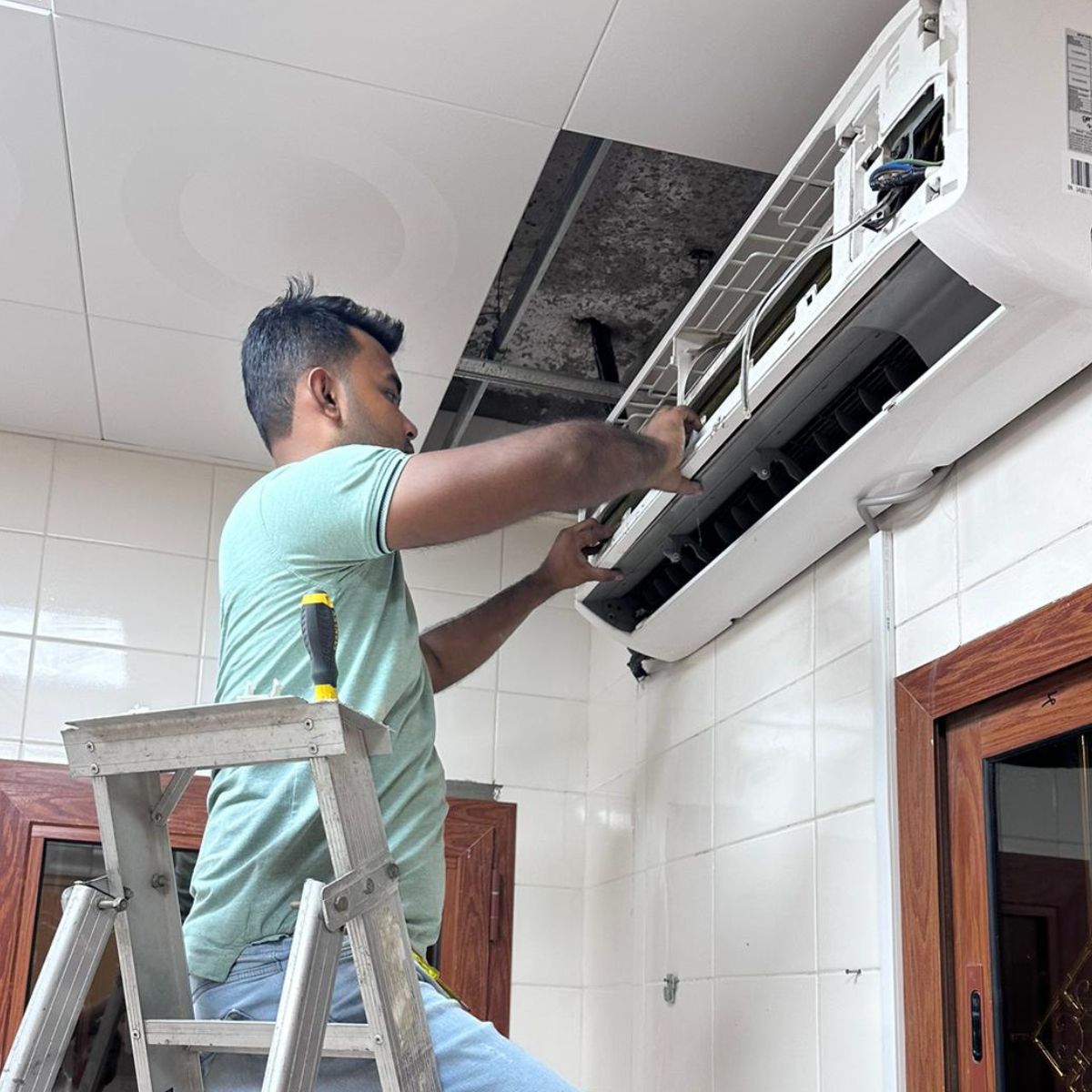How to Fix Low Refrigerant in AC Unit? To fix the low refrigerant in your AC unit, you need to hire a professional HVAC technician. By following this step, you can ensure a proper and accurate resolution for the issue.
Now let’s dive into more details about the importance of fixing low refrigerant in an AC unit. The refrigerant in an AC unit plays a crucial role in the cooling process. It absorbs heat from the indoor air and releases it outside, making your living space comfortable.
However, if your AC unit is low on refrigerant, it can cause various problems, such as reduced cooling performance, increased energy consumption, and potential damage to the compressor. To fix this issue, a trained technician will first identify and repair any leaks in the refrigerant lines, and then recharge the system with the appropriate amount of refrigerant. It is crucial to address low refrigerant promptly to ensure your AC unit operates efficiently and to avoid further damage and expensive repairs.
Signs Of Low Refrigerant In AC Units
Signs of low refrigerant in AC units include loss of cooling power, longer cooling cycles, reduced airflow, and ice formation on coils. If you notice any of these signs, it’s important to address the issue to prevent further damage to your AC unit.
Diagnosing Low Refrigerant Levels
Diagnosing low refrigerant levels in your AC unit is crucial to ensure optimal cooling performance. One way to check for low refrigerant is by examining the temperature differences in the system. Start by measuring the temperature of the air entering and leaving the evaporator coil. If the temperature difference is less than 15 degrees Fahrenheit, it may indicate low refrigerant levels.
Another step in diagnosing low refrigerant is inspecting the refrigerant lines. Look for any signs of oil residue or frost on the lines, as these could indicate a leak. Inspect the fittings and connections for any visible leaks as well.
Identifying the sources of leaks is a critical part of fixing low refrigerant levels. Use an electronic leak detector or ultraviolet dye to locate the leaks accurately. Once the leaks are found, repair them or replace the faulty components.
Using pressure gauges is also helpful in diagnosing low refrigerant levels. Attach the gauges to the AC unit and compare the readings to the manufacturer’s specifications. If the pressure is below the recommended range, it indicates a refrigerant deficiency in the system.
Step 1: Gather Necessary Tools And Materials
| Refrigerant gauge | Refrigerant | Safety gloves | Safety glasses |
To fix low refrigerant in your AC unit, you will need the following tools and materials: a refrigerant gauge, the appropriate refrigerant for your system, safety gloves, and safety glasses. These tools and materials are essential for ensuring a safe and effective repair process.
The refrigerant gauge is used to measure the pressure of the refrigerant in your AC unit, allowing you to determine if it is low. The correct type and amount of refrigerant must be used to replenish the system and restore its cooling capacity.
It is important to wear safety gloves and safety glasses while working with refrigerant. This will protect your hands and eyes from any potential harm that may arise during the repair process.
Step 3: Locate And Fix The Leak
When fixing low refrigerant levels in an AC unit, it is crucial to inspect common leak areas thoroughly. These areas may include the condenser coils, refrigerant lines, and valves. Look for any signs of oil stains, refrigerant residue, or physical damage that could indicate a leak.
After identifying potential leaks, evaluate the severity of each one. Determine whether the leak is minor, moderate, or severe. This assessment will help prioritize the repairs and understand the impact on cooling efficiency and system performance.
Next, proceed to repair the leaks. Depending on the severity, you may use different techniques such as patching minor leaks with epoxy or replacing damaged parts. Ensure that all leaks are properly sealed to prevent further refrigerant loss.
If the AC unit has damaged components that cannot be repaired, it is essential to replace them. This may include components like valves, coils, or fittings. Ensure that the replacements are compatible with the AC unit and properly installed.
Step 4: Recharge The AC unit With Refrigerant
To properly recharge your AC unit with refrigerant, you need to follow a series of steps. First, determine the correct refrigerant type for your specific unit. Consult the manufacturer’s guidelines or the unit’s manual to ensure you are using the appropriate refrigerant. Next, calculate the required amount of refrigerant based on the size and specifications of your AC unit.
Once you have the correct refrigerant and amount, attach a refrigerant gauge to the unit. This gauge will help you monitor and control the pressure as you add refrigerant. Make sure the gauge is securely attached and properly sealed to prevent any leaks.
Finally, you can begin safely adding refrigerant to the system. Follow the instructions provided by the manufacturer for your specific AC unit. Take your time and be cautious when adding refrigerant, as too much or too little can have negative effects on the unit’s performance. Regularly check the pressure levels on the gauge to ensure optimal levels are maintained.
Regular Maintenance And Inspections
When keeping your AC unit in top working condition, regular maintenance and inspections are essential. One important aspect of maintenance is checking for leaks. A refrigerant leak can lead to low refrigerant levels, which can hamper the cooling efficiency of your unit. It is crucial to inspect the refrigerant lines and connections for any signs of leakage and get them fixed immediately if detected.
Additionally, another upkeep task to ensure optimal performance is cleaning the coils and filters. Over time, dust and debris can accumulate on the coils and filters, reducing airflow and causing the unit to work harder. Regularly cleaning or replacing the filters and removing dirt from the coils can help maintain proper airflow and prevent low refrigerant issues.
Moreover, proper airflow is vital to maintaining adequate refrigerant levels. Make sure there are no obstructions around the vents and registers and ensure that air ducts are clean and unblocked. Ensuring proper airflow can help prevent low refrigerant levels due to improper cooling.
In addition to regular maintenance, it is important to test the system’s performance periodically. This can involve checking the cooling capacity, temperature differentials, and overall efficiency. Conducting system performance tests can help catch any problems early and optimize the refrigerant levels in your AC unit.
Prompt Leak Repairs
A low refrigerant level in an AC unit can lead to poor cooling performance and increased energy consumption. To ensure the optimal functioning of your system, it is crucial to address any leaks promptly.
When it comes to prompt leak repairs, the first step is to identify the source of the leak. This can be done by professionals who have the expertise and tools to detect and fix leaks efficiently. Hiring professional help ensures accurate diagnosis and reliable repair.
In addition to professional assistance, regularly monitoring the system for leaks is essential. This involves inspecting the refrigerant lines, connections, and fittings for any signs of damage or leakage. If any issues are found, they should be addressed immediately to prevent further refrigerant loss.
By promptly addressing leaks and hiring professional help if needed, you can maintain the optimal refrigerant level in your AC unit. Regular monitoring of the system ensures prompt detection and resolution of any potential leaks, ensuring efficient cooling and lower energy costs.
Can I Use Ac Freon for Mercedes Benz to Fix Low Refrigerant in AC Unit?
Yes, you can use specific ac freon for Mercedes Benz to fix low refrigerant levels in your AC unit. It’s important to use the recommended freon type to ensure the proper functioning and cooling performance of your Mercedes Benz’s air conditioning system.
Frequently Asked Questions
How Can Low Refrigerant Affect My AC Unit?
Low refrigerant can cause your AC unit to blow warm air and decrease cooling efficiency.
What Are The Signs Of Low Refrigerant In An AC Unit?
Signs of low refrigerant include reduced cooling performance, hissing noises, and ice buildup on the refrigerant lines.
How Can I Fix Low Refrigerant In My AC Unit?
Fixing low refrigerant requires professional help, as it involves locating and repairing leaks, and then recharging the refrigerant.
Conclusion
Fixing low refrigerant in your AC unit is essential for maintaining its efficiency and cooling capacity. By identifying the signs of low refrigerant, locating and repairing leaks, and properly recharging the system, you can ensure optimal performance and extend the lifespan of your AC unit.
Regular maintenance and professional assistance are crucial to prevent further damage and improve energy efficiency. Remember, a well-maintained AC unit not only provides comfort but also saves you money in the long run.








